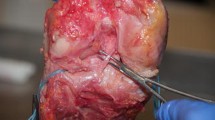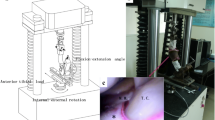Abstract
The aim of this study was to test the hypothesis that the meniscofemoral ligaments (MFLs) of the human knee assist the lateral meniscal function in reducing tibiofemoral contact pressure. Five human cadaveric knee joints were loaded in axial compression in extension using a 4-degree of freedom rig in a universal materials testing machine. Contact pressures pre- and post-sectioning of the MFLs were measured using pressure sensitive film. Sectioning the MFLs increased the contact pressure significantly in the joints for two of the four measures. In addition to their known function in assisting the posterior cruciate ligament (PCL) to resist tibiofemoral posterior drawer, the MFLs also have a significant role in reducing contact stresses in the lateral compartment. Their retention in PCL and meniscal surgery is therefore to be advised.


Similar content being viewed by others
References
Atkinson PJ, Newberry WN, Atkinson TS, Haut RC (1998) A method to increase the sensitive range of pressure sensitive film. J Biomech 31:855–859
Cho SD, Ko SH, Woo J-K (2006) Meniscus-stabilizing function of the meniscofemoral ligament: experimental study of pig knee joints. Arthroscopy 22:872–877
Friederich NF, O’Brien WR (1990) Functional anatomy of the meniscofemoral ligaments. Fourth Congress of the European Society for Knee Surgery and Arthroscopy (ESSKA), June 25–27, 1990, Stockholm, Sweden
Fukubayashi T, Kurosawa H (1980) The contact area and pressure distribution pattern of the knee. A study of normal and osteoarthrotic knee joints. Acta Orthop Scand 51:871–879
Gupte CM, Bull AMJ, Thomas RD, Amis AA (2003) A review of the function and biomechanics of the meniscofemoral ligaments. Arthroscopy 19:161–171
Gupte CM, Smith A, Jameison N, Bull AMJ, Thomas RD, Amis AA (2002) Meniscofemoral ligaments—structural and material properties. J Biomech 35:1623–1629
Gupte CM, Smith A, McDermott ID, Bull AMJ, Thomas RD, Amis AA (2002) Meniscofemoral ligaments revisited: anatomical study, age correlation and clinical implications. J Bone Joint Surg 84-B:846–851
Gupte CM, Bull AMJ, Thomas RD, Amis AA (2003) The meniscofemoral ligaments: Secondary restraints to posterior drawer. Analysis of anteroposterior and rotatory laxity in the intact and posterior-cruciate-deficient knee. J Bone Joint Surg 85-B:765–773
Gupte CM, Bull AMJ, Murray R, Amis AA (2007) Comparative anatomy of the meniscofemoral ligament in humans and some domestic mammals. Anat Histol Embryol 36:47–52
Krause WR, Pope MH, Johnson RJ, Wilder DG (1976) Mechanical changes in the knee after meniscectomy. J Bone Joint Surg 58-A:599–604
Last RJ (1948) Some anatomical details of the knee joint. J Bone Joint Surg 30-B:683–688
McDermott ID, Lie DTT, Sharifi F, Bull AMJ, Thomas RW, Amis AA (2002) Lateral meniscal allograft transplantation. Surgical Technique and study of the effects on intra-articular contact pressures. J Bone Joint Surg 86B(Supp IV):445
Morrison JB (1970) The mechanics of the knee joint in relation to normal walking. J Biomech 3:51–61
Radoïévitch S (1931) Les ligaments des menisques interarticulaires du genou. Ann Anat Path 8:400–413
Scholes SC, Bull AMJ, Unsworth A, Amis AA (2004) Biomechanics of articulations and derangements in disease. In: Isenberg DA, Maddison PJ, Woo P, Glass D, Breedveld FC (eds) Oxford textbook of rheumatology, 3rd edn. Oxford University Press, NY, USA, pp 379–387
Seedhom BB, Hargreaves DJ (1979) Transmission of the load in the knee joint with special reference to the role of the menisci II. Eng Med 8:220–228
Shrive NG, O’Connor JJ, Goodfellow JW (1978) Load-bearing in the knee joint. Clin Orthop Relat Res 131:279–287
Vedi V, Williams A, Tennant SJ, Spouse E, Hunt DM, Gedroyc WM (1999) Meniscal movement. An in vivo study using dynamic MRI. J Bone Joint Surg 81-B:37–41
Weightman B (1976) Tensile fatigue of human articular cartilage. J Biomech 9:193–200
Acknowledgments
This project was funded in part by the Arthritis Research Campaign; C. M. Gupte was supported by the S&N foundation and the RCS Edin; D. T. T. Lie was supported by the Department of Health of the Government of Singapore. The Instron machine was provided by an equipment grant from the ARC. We also thank the Pathology Department of Ealing Hospital for their assistance.
Author information
Authors and Affiliations
Corresponding author
Rights and permissions
About this article
Cite this article
Amadi, H.O., Gupte, C.M., Lie, D.T.T. et al. A biomechanical study of the meniscofemoral ligaments and their contribution to contact pressure reduction in the knee. Knee Surg Sports Traumatol Arthr 16, 1004–1008 (2008). https://doi.org/10.1007/s00167-008-0592-0
Received:
Accepted:
Published:
Issue Date:
DOI: https://doi.org/10.1007/s00167-008-0592-0




